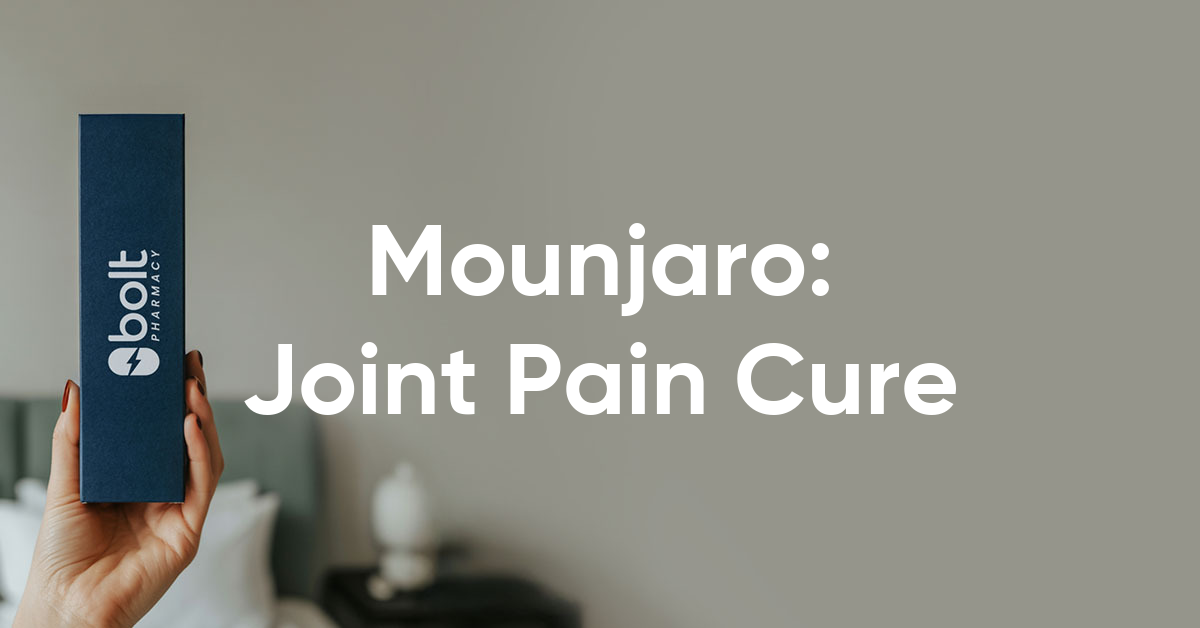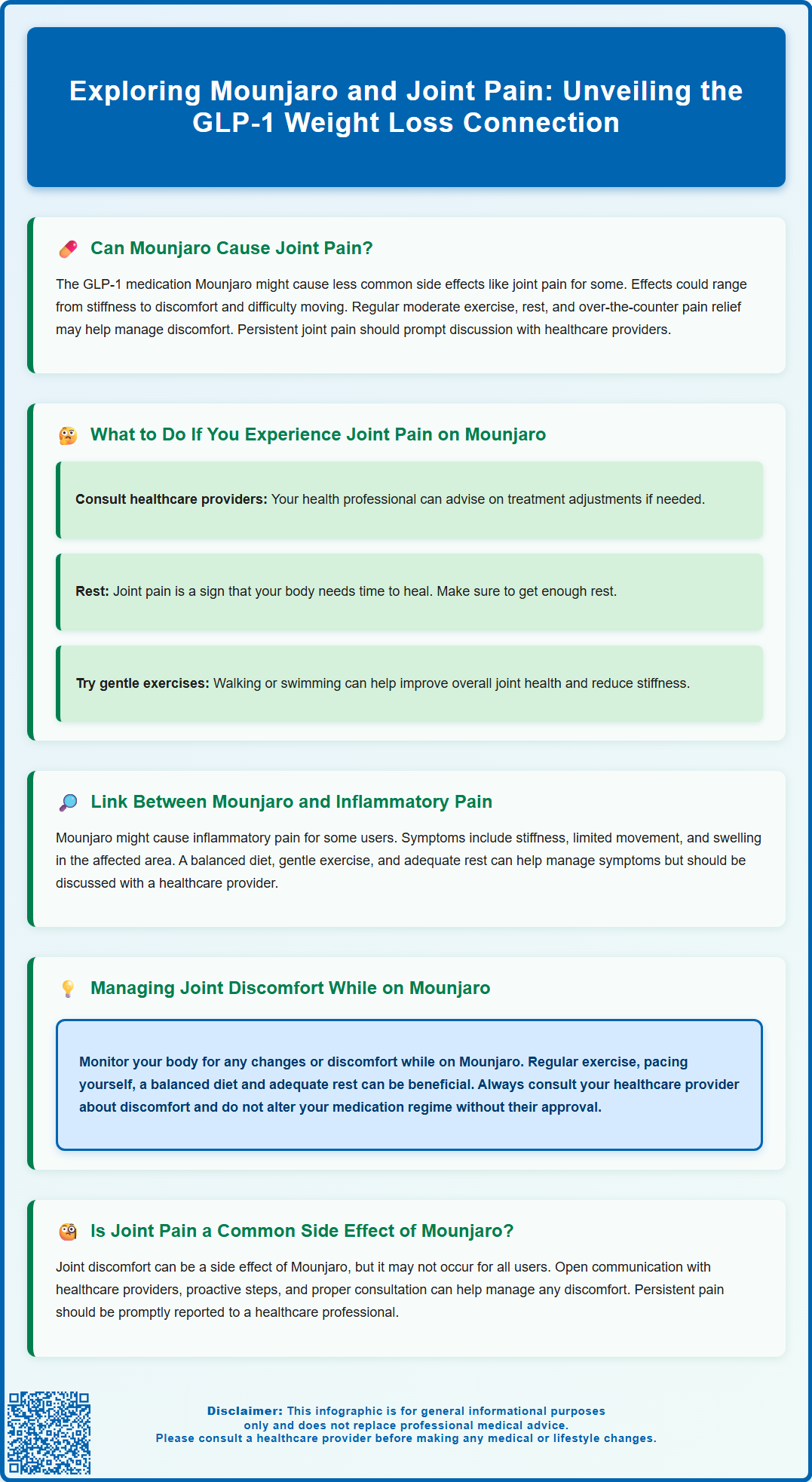
Mounjaro (tirzepatide) is a dual GIP/GLP-1 receptor agonist licensed in the UK for treating type 2 diabetes in adults. Whilst gastrointestinal symptoms are the most commonly reported side effects, some patients have questioned whether Mounjaro and joint pain are connected. Joint pain is not listed among the most frequent adverse effects in official prescribing information, though musculoskeletal symptoms including arthralgia have been documented in clinical trials at rates similar to placebo. This article examines the available evidence, explores potential mechanisms, and provides guidance on managing joint discomfort whilst taking Mounjaro.
Summary: Joint pain is not established as a direct side effect of Mounjaro (tirzepatide), though musculoskeletal symptoms occur in 3-7% of patients at rates similar to placebo.
Mounjaro is the brand name for tirzepatide, a prescription medicine licensed in the United Kingdom for the treatment of type 2 diabetes mellitus in adults. It belongs to a novel class of medications that act as dual agonists, targeting both glucose-dependent insulinotropic polypeptide (GIP) and glucagon-like peptide-1 (GLP-1) receptors. This dual mechanism enhances insulin secretion when blood glucose levels are elevated, suppresses glucagon release, slows gastric emptying, and reduces appetite, thereby improving glycaemic control and often leading to significant weight loss.
Mounjaro is administered as a once-weekly subcutaneous injection, with treatment starting at 2.5 mg for 4 weeks as an initiation dose (not intended for glycaemic control). The dose is then increased to 5 mg, with potential further increases by 2.5 mg every 4 weeks up to a maximum of 15 mg, depending on individual response and tolerability. The Medicines and Healthcare products Regulatory Agency (MHRA) approved tirzepatide following clinical trials demonstrating significant reductions in HbA1c levels (typically 1.5-2.1%) and body weight (5-11 kg) compared to placebo and other diabetes medications.
Like all medicines, Mounjaro can cause side effects, although not everyone experiences them. According to the Summary of Product Characteristics (SmPC), the most commonly reported adverse effects are gastrointestinal in nature, including nausea (12-24%), diarrhoea (13-22%), vomiting (6-10%), constipation (5-9%), abdominal pain, and reduced appetite. These symptoms are usually mild to moderate in severity and tend to diminish over time as the body adjusts to the medication. Other recognised side effects include injection site reactions, fatigue, and increased heart rate (reported as 'uncommon', affecting less than 1 in 100 people). Serious but rare adverse effects include pancreatitis, gallbladder disease, and hypoglycaemia, particularly when Mounjaro is used in combination with insulin or sulphonylureas. Understanding the expected side effect profile helps patients and healthcare professionals distinguish between common, self-limiting symptoms and those requiring medical attention.

Joint pain, medically termed arthralgia, has been reported by some individuals taking Mounjaro, though it is not listed among the most common side effects in the official Summary of Product Characteristics (SmPC) or patient information leaflet. During the pivotal clinical trials for tirzepatide, musculoskeletal symptoms including back pain (reported in 4-7% of participants) and arthralgia (3-5%) were documented, but these occurred at frequencies similar to placebo groups in most studies according to the European Medicines Agency's European Public Assessment Report (EPAR).
Post-marketing surveillance and real-world data collection continue to monitor adverse effects that may not have been fully apparent during clinical trials. Some patients have reported experiencing joint discomfort or pain after starting Mounjaro, though establishing a direct causal relationship remains challenging. It is important to recognise that correlation does not necessarily imply causation, and joint pain is a common symptom in the general population, particularly among individuals with type 2 diabetes who may have concurrent conditions such as obesity, osteoarthritis, or inflammatory joint disease.
Currently, there is no official, established link between Mounjaro and joint pain as a direct pharmacological effect of tirzepatide. The European Medicines Agency (EMA) and MHRA have not issued specific warnings regarding arthralgia as a significant adverse reaction. However, healthcare professionals remain vigilant for emerging safety signals, and patients are encouraged to report any new or worsening symptoms through the MHRA Yellow Card Scheme (yellowcard.mhra.gov.uk). The absence of a proven causal link does not invalidate individual experiences, and any persistent or troublesome joint pain warrants proper clinical assessment to identify the underlying cause and ensure appropriate management.
Several hypothetical mechanisms might explain why some individuals experience joint pain whilst taking Mounjaro, even if a direct pharmacological cause has not been established. Firstly, rapid weight loss, which commonly occurs with tirzepatide therapy, can alter biomechanics and place different stresses on weight-bearing joints. As body composition changes, the musculoskeletal system must adapt, and this transition period may temporarily manifest as joint discomfort, particularly in the knees, hips, and lower back.
Secondly, changes in fluid balance and hydration status due to gastrointestinal side effects such as nausea, vomiting, and diarrhoea could potentially contribute to musculoskeletal symptoms, though this remains speculative without robust evidence.
Another important consideration is the possibility of coincidental timing. Type 2 diabetes is associated with increased prevalence of musculoskeletal conditions including osteoarthritis, diabetic cheiroarthropathy, and diffuse idiopathic skeletal hyperostosis. Gout is also more common in people with diabetes and metabolic syndrome, and acute flares can be triggered by dehydration or changes in diet. Patients starting Mounjaro may already have subclinical joint pathology that becomes symptomatic during the treatment period for unrelated reasons. Furthermore, increased physical activity following improvements in glycaemic control and energy levels might unmask pre-existing joint problems or lead to overuse injuries.
It is worth noting that while idiosyncratic reactions are theoretically possible with any medication, there is currently no evidence to support an inflammatory arthropathy directly caused by Mounjaro. A thorough clinical assessment is essential to differentiate between these various possibilities and guide appropriate management strategies.
If you experience joint pain whilst taking Mounjaro, several practical strategies may help alleviate symptoms whilst continuing your diabetes treatment. Firstly, ensure adequate hydration by drinking sufficient water throughout the day, particularly if you are experiencing gastrointestinal side effects. Proper hydration supports overall musculoskeletal function.
Gentle, regular physical activity is generally beneficial for joint health. Low-impact exercises such as swimming, cycling, or walking can maintain joint mobility and strengthen supporting muscles without placing excessive stress on painful areas. Physiotherapy assessment may be valuable, particularly if pain is affecting daily activities or quality of life. A physiotherapist can provide tailored exercises, manual therapy techniques, and advice on activity modification.
For pain relief, paracetamol is usually the safest first-line option for mild to moderate joint pain. For localised joint pain, topical non-steroidal anti-inflammatory drugs (NSAIDs) such as ibuprofen gel can be effective with fewer systemic side effects than oral NSAIDs. Oral NSAIDs should be used cautiously in people with diabetes, particularly those with renal impairment, heart failure, history of peptic ulcers, or cardiovascular risk factors. They may also interact with medications commonly prescribed in diabetes, including ACE inhibitors, angiotensin receptor blockers, and diuretics. Always consult your GP or pharmacist before starting any new medication, even those available without prescription.
Maintaining a healthy weight through balanced nutrition supports joint health, though rapid weight loss should be monitored. If joint pain coincides with the initiation or dose escalation of Mounjaro, discuss with your healthcare team whether temporarily maintaining your current dose might allow symptoms to settle before further increases.
Keeping a symptom diary can help identify patterns, triggers, and the severity of joint pain, providing valuable information for clinical consultations. Document when pain occurs, its location, intensity, duration, and any factors that improve or worsen symptoms.
Whilst mild, transient joint discomfort may not require immediate medical attention, certain features warrant prompt evaluation by your GP or diabetes specialist. Seek medical advice if joint pain is severe, persistent, or progressively worsening despite simple measures. Pain that significantly interferes with daily activities, sleep, or quality of life should be assessed professionally.
Red flag symptoms requiring urgent medical attention include joint pain accompanied by fever, significant swelling, redness, or warmth over the affected joint, which may indicate infection (septic arthritis) or inflammatory arthritis. Sudden onset of severe pain in a single joint, particularly if associated with inability to bear weight or move the joint, requires same-day assessment to exclude conditions such as gout or septic arthritis. If you develop a widespread rash, mouth ulcers, or other systemic symptoms alongside joint pain, contact your healthcare provider promptly.
If a joint is hot, swollen, very painful with fever or you feel systemically unwell, seek same-day urgent care via your GP, NHS 111, or go to A&E, as these may indicate serious conditions requiring immediate treatment.
It is also important to seek advice if joint pain is accompanied by other concerning symptoms such as unexplained weight loss (beyond expected therapeutic effects), persistent fatigue, night sweats, or any signs of infection. Patients with pre-existing joint conditions such as rheumatoid arthritis or osteoarthritis should report any significant change in their usual symptom pattern.
Before your appointment, prepare information about the location, character, and timing of your joint pain, any aggravating or relieving factors, and a list of all medications and supplements you are taking. Your doctor will conduct a thorough assessment, which may include physical examination of affected joints and potentially blood tests or imaging studies to identify the underlying cause. Depending on findings, management may involve simple analgesia, physiotherapy referral, adjustment of your Mounjaro dose, or investigation for alternative diagnoses.
If you suspect your joint pain may be related to Mounjaro, you can report this as a potential side effect through the MHRA Yellow Card Scheme (yellowcard.mhra.gov.uk). Never discontinue Mounjaro without medical guidance, as maintaining good glycaemic control remains essential for your overall health and reducing diabetes-related complications.
Joint pain is not listed among the most common side effects of Mounjaro. Clinical trials reported arthralgia in 3-5% of patients, occurring at similar rates to placebo groups, with no established causal link confirmed by UK regulators.
Maintain adequate hydration, engage in low-impact exercise, and consider paracetamol for mild pain. Consult your GP if pain is severe, persistent, or accompanied by swelling, redness, fever, or significantly affects daily activities.
Rapid weight loss may alter biomechanics and place different stresses on weight-bearing joints during the body's adaptation period. This theoretical mechanism could contribute to temporary joint discomfort, particularly in the knees, hips, and lower back.
The health-related content published on this site is based on credible scientific sources and is periodically reviewed to ensure accuracy and relevance. Although we aim to reflect the most current medical knowledge, the material is meant for general education and awareness only.
The information on this site is not a substitute for professional medical advice. For any health concerns, please speak with a qualified medical professional. By using this information, you acknowledge responsibility for any decisions made and understand we are not liable for any consequences that may result.
Lorem ipsum dolor sit amet, consectetur adipiscing elit, sed do eiusmod tempor incididunt ut labore et dolore magna aliqua. Ut enim ad minim veniam, quis nostrud exercitation ullamco laboris nisi ut aliquip ex ea commodo consequat. Duis aute irure dolor in reprehenderit in voluptate velit esse cillum dolore eu fugiat nulla pariatur.
Block quote
Ordered list
Unordered list
Bold text
Emphasis
Superscript
Subscript